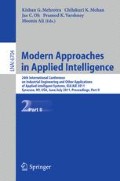Abstract
Evolutionary computation techniques are being frequently used in the field of robotics to develop controllers for autonomous robots. In this paper, we evaluate the use of Genetic Programming (GP) to evolve a controller that implements an Obstacle Avoidance (OA) behavior in a miniature robot. The GP system generates the OA logic equation offline on a simulated dynamic 2-D environment that transforms the sensory inputs from a simulated robot to a controller decision. The goodness of the generated logic equation is computed by using a fitness function that maximizes the exploration of the environment and minimizes the number of collisions for a fixed number of decisions allowed before the simulation is stopped. The set of motor control decisions for all possible sensor trigger sequences is applied to a real robot which is then tested on a real environment. Needless to say, the efficiency of this OA robot depends on the information it can receive from its surroundings. This information is dependant on the sensor module design. Thus, we also present a Genetic Algorithm (GA) that evolves a sensor arrangement taking into consideration economical issues as well as the usefulness of the information that can be retrieved. The evolved algorithm shows robust performance even if the robot was placed in completely different dynamically changing environments. The performance of our algorithm is compared with that of a hybrid neural network and also with an online (real time) evolution method.
Access this chapter
Tax calculation will be finalised at checkout
Purchases are for personal use only
Preview
Unable to display preview. Download preview PDF.
References
Cliff, D.: Computational neuroethology: a provisional manifesto. In: Proceedings of the First International Conference on Simulation of Adaptive Behavior on From Animals to Animats, pp. 29–39. MIT Press, Cambridge (1990)
Harvey, I., Husbands, P., Cliff, D.: Issues in evolutionary robotics. In: Proceedings of the Second International Conference on From Animals to Animats 2: Simulation of Adaptive Behavior: Simulation of Adaptive Behavior, pp. 364–373. MIT Press, Cambridge (1993)
Koza, J.R.: Genetic programming: on the programming of computers by means of natural selection. MIT Press, Cambridge (1992)
Nolfi, S., Floreano, D., Miglino, O., Mondada, F.: How to evolve autonomous robots: different approaches in evolutionary robotics. In: Artificial Life IV, pp. 190–197. MIT Press/Bradford Books (1994)
Nordin, P., Banzhaf, W.: A genetic programming system learning obstacle avoiding behavior and controlling a miniature robot in real time. Tech. rep., The University of Dortmund (1995)
Reynolds, C.W.: Evolution of obstacle avoidance behavior: using noise to promote robust solutions, pp. 221–241. MIT Press, Cambridge (1994)
Spanache, S., Escobet, T., Trav-massuys, L.: Sensor placement optimisation using genetic algorithms. In: Proceedings of the 15th International Workshop on Principles of Diagnosis, DX 2004, pp. 179–183 (2004)
Author information
Authors and Affiliations
Editor information
Editors and Affiliations
Rights and permissions
Copyright information
© 2011 Springer-Verlag Berlin Heidelberg
About this paper
Cite this paper
Chandrasekaran, M., Nadig, K., Rasheed, K. (2011). Evolving Efficient Sensor Arrangement and Obstacle Avoidance Control Logic for a Miniature Robot. In: Mehrotra, K.G., Mohan, C.K., Oh, J.C., Varshney, P.K., Ali, M. (eds) Modern Approaches in Applied Intelligence. IEA/AIE 2011. Lecture Notes in Computer Science(), vol 6704. Springer, Berlin, Heidelberg. https://doi.org/10.1007/978-3-642-21827-9_36
Download citation
DOI: https://doi.org/10.1007/978-3-642-21827-9_36
Publisher Name: Springer, Berlin, Heidelberg
Print ISBN: 978-3-642-21826-2
Online ISBN: 978-3-642-21827-9
eBook Packages: Computer ScienceComputer Science (R0)

